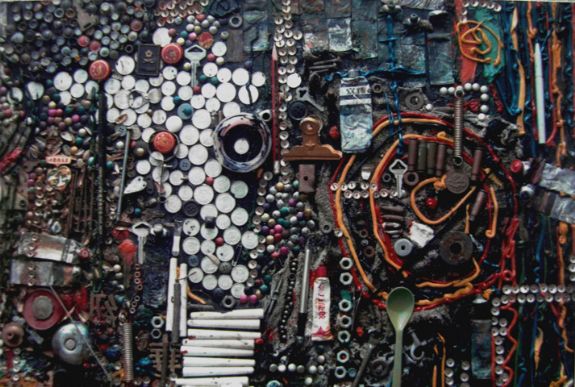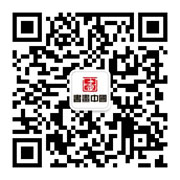|
|
|
 |
新闻详细信息 |
 |
|
|
|
文化权力的无常
时间:2013-4-1 14:01:09 点击次数:7159 |
——解读胡志颖
● 王璜生
在我们这个社会和年代,脑袋里、眼睛里装满了种种文化的影像。公共的、私密的、东方的、西方的、古典的、现代的……彼此交叉缠绕,构成一种独特而庞杂的文化图像,每个人都以自己独特的方式来吸摄和重组这样一些图像,并构成每个人自身的“文化概念”和“文化权力”。每个人似乎可以理直气壮地去述说作为文化的意义,但同时,每个人却又发现自己的“文化”无可依归,不知自己的“文化图像”符号落实在何处,不知何为自己的图像基础,何为外来强行进入的符号因素。多重的文化符号本身正构成一种独特的符号文化。因此,艺术家自觉而敏感地对这种符号文化以体验、感觉和表现,而同时,艺术家自身所具备的理性精神和权力意志却常常对这种文化提出疑问,对这种文化的基础及存在的合理性发出追问。胡志颖正是属于这种敏于感觉又善于追问的艺术家。正因为他敏于感觉,因此在他的艺术表现中呈现为多元且庞杂的视觉影像,使我们似乎在一种无序和对抗中感受到生命的茫然和丰富,仿佛在一个无限的时空中穿梭与碰撞,一片诱惑的红色像巨大能量的旋涡令无常的生命如蜉蝣一样眩转。意识跳跃般的闪亮;另一方面,又因为他善于追问,因而在这穿越时空的茫然眩转中,我们感觉到一种理性力量的存在,追问一种文化的存在与构成,有如追问生命存在的意义和价值,尤其是在无序的文化状态中,这种追问更需要一种意志的力量,用意志去叩问无常。
于是,胡志颖因一篇鸿论《艺术无常论》惹起了一场风波,个人的思考和表达成了对所谓权威的挑战。如果说意志和性格能够战胜世俗和名利欲望,能够战胜自我的生命懦弱,但,它却无法面对代表着“文化”的权力和权威,因为权力有权不与他面对面,不与他争论。福柯认为,话语和权力联结在一起,没有权力也就构不成话语,没有话语也等于没有了权力。这正应验于胡志颖的论点:艺术无常、文化无常,那么,权力有常吗?
文化的主要问题是权力问题,从大的空间讲,以西方为权力中心的“西方文化主义”和东方被迫抵制意志和附和潜意识的“东方主义”,构成了一个权力重新分配及碰撞、抗争、消解的局面,不同的文化在这其中所呈现出来的话语因素及趋向,其潜台词和潜在的可能性始终联结着出席权和在场权问题。而对同一个文化问题的提出和接受,如“认同与差异”(“第46届威尼斯双年展”的主题),东西方都以自己的权力话语进行着各自的表达,并在表达中尽可能争取着权力的体现。而作为区域、群组、个人,这种文化的权力构成及存在也同样是暴露性和侵犯性的,各自都在争取发言的权利,而彼此的发言却相互干扰、相互抵消;各自都在争取和构成自己的文化权力,但却发现自己的文化权力在众多他人的文化权力中显得微不足道以至于彼此消解,并且往往被超越文化之外的权力所侵犯和践踏。这一切都似乎包孕着最深层的无奈,而更无奈的还在于个性心理所构成的文化堡垒彼此的独立、冲撞、无法沟通和无可奈何。作为艺术家,只能在感觉和表现的可能范围和权力许可中来思考和发问这并置、冲撞、消解的文化心理问题。
因此,在胡志颖的作品中,我们似乎感觉到他个人文化影像的一层层剥离和呈现、一次次拆解和重组,而同时,这种文化影像却不仅仅是个人的意义,而是一次次地指向更广阔的地域和文化空间,对重大的文化构成提出充满理性和意志的质疑。
可以看到,对古典的宋画、对狂野的民间艺术、对水墨表现性的独特感觉,以及蕴涵理性的张力,这构成了胡志颖个人文化影像的基础。从他早期的种种作品(图1,2,3)以及他对书法和水墨抽象的兴趣,我们似乎可以为他的图像脉络理出一些依据。在他近期的作品中,经常出现一些南宋山水符号,甚至很明确的马远《踏歌图》符号,还有红、黑、金、银的民间色彩构成和民间髹漆原料,以及笔墨表现性很强的局部抽象元素,由此我们也许可以轻易地将之归类为东方式的文化影像。但是问题并非如此简单和清晰,当我们认可于某种东西为基础以吸纳重组时,也许我们碰到的最大难题是对这种基础的怀疑,我们的吸纳和重组在这种怀疑中变得犹豫不定且无所适从。这也许是一种意识过程,也是文化发生和发展的过程。胡志颖正是重视于意识的过程,以意识的过程来表述文化的状态。于是,在他的画面,意识一层层地展开,文化的影像层叠显现出来,追问、怀疑、撞击成了文化意识本身。从他的画面,我们似乎感觉到一种对现代艺术之父塞尚的怀疑而崇敬的态度;对时空意识瓦解的关注和幽冥神秘境界的眷恋;对宗教感的怀念和消解;对心理空间的跨越和冻结;对生命本身的热情熔铸和理性剖析……胡志颖正是企图以这种文化影像的多重性构筑它们新一层的意义。如果说,作为艺术家的胡志颖以文化的并置和撞击过程完成他作为艺术家的表现意义的话,那么,作为理性沉思者的胡志颖却从这里为起点,进一步追问和怀疑文化的权力问题,而他的结论却落实在“无常”上:我们无法分清宋代艺术在当代中国生活关系中潜在的意义及权力指向的能量,以及这种指向和能量与现代或后现代艺术之间在当代社会中构成的文化关系;我们无法面对“踏歌”式田园牧歌的精神向往与暴力恐惧潜伏的欲望激刺并置于一个共同的心理空间;我们无法在一种红色的狂热和世俗的煽情中接受一种墨色的宗教冥思……在这里,作为个人的文化权力和作为社会、公众的文化权力既互相对抗、冲突又时而合谋、消解,当我们自认获得一种文化权力和话语方式并进行个人的发言时,其终了却无奈地发现自己的话语其实是他人的话语所暗示(侵犯)的结果,自己的所谓权力往往是他人权力武器中的一个小齿轮,它无奈地被动地运转着。这也许就是胡志颖企图对以权力为支点的文化所做的怀疑和追问,追问的结果却是无奈的。于是,他只能为自己的一系列作品起无奈的标题:“五·一 己巳 6·9 五·十一 已卯 6·19 五·二十一 己丑 6·29”、“九·一 癸卯 10·20 九·十一 癸丑 10·30 九·二十一 癸亥 11·9”、“周贞定王元年癸酉(公元前468年)”等等,这些与画面似乎无任何联系的标题,你完全可以怀疑其用意和其意义,而这种怀疑正是胡志颖的用意和意义之所在。
毕竟,胡志颖是艺术家,艺术家的许多工作是落实在具体的甚至是工匠式的技术操作层面上的。没有这种技术操作和技术难度,任何意义的怀疑和追问将是一团迷雾状的空想。尽管,胡志颖对外部空间的文化权力有着无奈的感觉,但,他却对自己艺术所应具有的权力意志十分明确。也就是说,他对自己的艺术语言有着明确的建构指向,他选择工艺技术性极强的髹漆手艺来切入当代文化表现和思考,注重甚至可称考究于色彩、材料(包括画布、木板、阳江漆、大漆、金银粉箔、硍硃等等)以及画面符号、线条、块面的可欣赏性,以此来建构他的艺术话语的堡垒。
当然,我这样解读胡志颖,对于他人来说未必有意义,对于胡本人来说,也同样可能是文化权力侵犯的结果,这正是当代文化的无奈。我以我的文化权力言说一种艺术存在和现象,而胡志颖和他者,也同样以其各自的文化意志构建各自的文化堡垒。在一个貌似开放且信息覆盖强度空前的后现代社会,解构成了一种时髦和必然的选择,但解构并不是拆除堡垒之墙,而是各自在滥用和加强自己的文化权力,以之侵犯和消解他人的权力,而彼此的加强和消解、权力的聚集和抵消,这正是当代世界文化范围内的必然趋势。
(原载《江苏画刊》1997年第二期,江苏美术出版社)
The Transiency of Cultural Power
——Reading Hu Zhiying
Wang Huangsheng
In our age and society, our minds and eyes are filled with various cultural images. Public, private; east, west; classical, modern…They intersect each other and intertwine together, constituting a kind of unique, numerous and jumbled cultural images. Everyone absorbs and regroups these images in his own unique way and constructs “cultural concept” and “cultural power” of his own. It seems that everyone can give an account of the significance of culture with perfect assurance, yet at the same time, everyone finds that it is difficult to decide what category his “culture” or symbols of “cultural images” should be included in. He cannot tell what are the basic sources of his images and what are symbols forced in from outside. Multiple cultural symbols themselves are constituting a kind of symbol culture. Therefore, while artists experience, perceive and express this symbol culture consciously and sensitively, their own rational spirit and power consciousness often cause them to question this culture and make detailed inquiries about its foundation and reason of existence. Hu Zhiying is just an artist sensitive and good at questioning. Just because he is sensitive, multiple, numerous and jumbled visual images are represented in his art, making us seem to sense the aimlessness and richness of life in disorder and antagonism, as if things are shuttling and colliding in limitless time and space, and a stretch of enchanting red, like a vortex with tremendous energy, makes transient lives dizzy as ephemeras are. Consciousness flashes just as jumping. On the other hand, because he is good at questioning, we sense, in the aimlessness and dizziness through time and space, the existence of a kind of rational power which questions the existence and structure of a culture, as if questioning the significance and value of the existence of life. This questioning, especially in the out-of-order cultural situation, needs the power of will with which to question transiency.
Therefore, Hu Zhiying got himself into trouble with his brilliant paper About the Transiency of Art, and the mere presentation of his personal meditation was considered a challenge to the so-called authority. If will and character can conquer earthliness, the desire for personal fame and gain, and one’s cowardice, they cannot confront the power and authority representing the “culture”, for power has the right to refuse to debate with him face to face. According to Foucault, discourse and power are so linked that without power there would be no discourse and without discourse power would also be meaningless. It just confirms Hu Zhiying’s viewpoint: if art and culture are transient, is power permanent?
The main problem of culture is that of power; in a broader context, “Western Culturalism” with the West as its center of power and “Orientalism” of the East in which one is forced to resist his will and to follow the sub-consciousness form a situation in which powers are re-allocated and they collide with each other, resist each other, and will dissolve. The subtext and potential possibilities of the discourse elements and tendencies of different cultures shown in this situation are always connected with the right of attendance and the right of presence. The advancing and accepting of the same cultural problem, for example, “Identity and Difference” (the theme of the 46th Venice Biennale), are expressed by the East and the West with their respective power discourse, and in this process they both try to embody their power as much as possible. For regions, groups and individuals, the power of culture is also exposed and aggressive in its construction and existence. They all strive for the right to speak but their speeches interfere with and cancel out each other; they all strive for, and try to form, their own cultural power but they find that their own cultural power is so insignificant among multitudinous cultural powers of others that their powers dissolve each other and are often violated and trampled on by powers beyond culture. All this seems to involve deepest helplessness, and what is more helpless lies in the fact that the cultural fortresses constituted by personal mentalities are mutually independent, they conflict with each other, they are unable to communicate with each other and they are helpless. Artists can meditate and question these problems of cultural psychology about juxtaposing, colliding and dissolving only within the limit of possibilities of perceiving and expressing and the range permitted by the authority.
Therefore, it seems that we can sense, in Hu Zhiying’s works, the peeling off and representing, layer after layer, and disassembling and regrouping, time and again, of his personal cultural images. While at the same time, these cultural images not only have personal significance, but also point to a wider area and cultural space, raising questions full of reason and will about significant cultural constructions.
We can see that the unique feeling about the classical Song Dynasty paintings, the wild folk art and the expressiveness of ink and wash paintings and the tension with reason contained in it constitute the foundation of Hu Zhiying’s personal cultural images. It seems that we can find some indications of the sources of his images in his early works of various types and in his interest in calligraphy and abstract ink and wash painting. In his recent works, we often see symbols from landscape paintings of the Southern Song Dynasty, even those obviously from Ma Yuan’s Walking While Singing (“Ta Ge Tu”), folk color composition of red, black, gold and silver, folk materials of lacquering, and loca abstract elements with strong expressiveness of brush and ink; hence perhaps we can classify them among eastern style cultural images. However, the problem is not so simple and clear. When we take something as the basis for our absorption and regrouping, the most difficult problem we meet is perhaps our suspicion about this basis, and we become hesitative and perplexed in our absorption and regrouping. Maybe it is a process of consciousness, and also a process of the emergence and development of culture. Hu Zhiying attaches importance to the process of consciousness and represents the state of culture through it. So in his paintings, consciousness is unfolded layer after layer and cultural images are displayed one after another; questioning, suspecting and colliding become the cultural consciousness itself. In his paintings, we seem to sense a kind of suspicion about and reverence for Cezanne, the father of modern art; the attention to the collapse of the sense of time and space and the deep affection for the mysterious realm; the nostalgic yearning for and the dissolving of the sense of religion; the surpassing of the mental space and its freezing; the passionate casting of life itself and the rational analysis of it…It is with this multiplicity of these cultural images that Hu Zhiying attempts to construct a new layer of their meanings. If Hu Zhiying as an artist attains his purpose of expression through the process of juxtaposition and collision of different cultures, then Hu Zhiying as a rational contemplator takes this process as a starting point and examines and questions further the problem of the cultural power, and his conclusion tends to be “transiency”: we cannot get a clear idea about the potential significance and the energy of power orientation of Song Dynasty art in public life relationship of contemporary China, and the cultural relationship constituted between this orientation and energy and modern or post-modern art in contemporary society; we cannot face the juxtaposition of the idyllic spiritual yearning exemplified by “walking while singing” and the stimulation of desire with violence and terror latent in it in the common mental space; we cannot accept a kind of ink dark religious meditation amid the red fanaticism and secular emotion instigation…Here, personal cultural power and social and public cultural power both resist and conflict with each other and conspire with and dissolve each other. When we think we have acquired a kind of cultural power and a mode of discourse and make a personal speech, we find helplessly in the end that our own discourse is in fact the result of the hint from (or the violation by) the discourse of the others, and the so-called power of our own is often a small gear in the weapon of power of the others, rotating helplessly and passively. Maybe this is what Hu Zhiying doubts and attempts to question about the culture with power as its pivot, but the result of this questioning is helpless. Therefore, he can only give his series of works helpless titles: “The First Day of the Fifth Lunar Month of the Jisi Year, June 9; The Eleventh Day of the Fifth Lunar Month of the Yimao Year, June 19; The Twenty-First Day of the Fifth Lunar Month of the Jichou Year, June 29”, “The First Day of the Ninth Lunar Month of the Guimao Year, October 20; The Eleventh Day of the Ninth Lunar Month of the Guichou Year, October 30; The Twenty-First Day of the Guihai Year, November 9”, “Guiyou, The First Year of the Reign of King Zhending of Zhou (468 B.C.)”, etc. You can certainly doubt the intention and meaning in using these titles that seem to have nothing to do with the paintings themselves, and it is in this doubt that Hu Zhiying’s intention and meaning lie.
After all, Hu Zhiying is an artist, and most of the work of an artist lies in concrete technical operations or even those of a craftsman. Without these operations and degrees of difficulty in techniques, any doubt and questioning would be fog-like fantasy. Although Hu Zhiying feels helpless towards the cultural power of the outside world, he is quite clear about the power his own art should have. In other words, he has a clear direction in establishing his own art language, and he chooses to use lacquering, a sophisticated technique, in expressing contemporary culture and his thinking about it, and lays stress on, and even is very particular about, the enjoyability of color, materials (including canvas, wood plate, Yangjiang paint, lacquer, gold and silver powder and foil, and vermilion), symbols, lines and masses, and tries to construct his fortress of art discourse with them.
Of course my reading of Hu Zhiying in this way may not be meaningful for others, and may similarly be the result of the violation of the cultural power for Hu Zhiying himself, and this is exactly the helplessness of contemporary culture. I give an account of a kind of artistic existence and phenomenon with my own cultural power, while Hu Zhiying and others are constructing their own respective cultural fortresses with their own will of culture. In a post-modern society seemingly open and with unprecedented information coverage, deconstruction becomes a fashion and an inevitable choice. However, deconstruction does not mean demolishing the walls of the fortresses; instead, people are abusing and strengthening their own cultural power respectively with which to violate and dissolve others’ power. The mutual strengthening and dissolving, the converging and mutual canceling out of power is just an inevitable tendency in the contemporary world culture.
(Originally published in Jiangsu Art Monthly, No. 2, 1997, published by Jiangsu Fine Arts Publishing House)
(图1)
自画像(局部) 1990-1991,布上油彩、蛋胶,110X110cm
(Fig. 1)
Self-portrait (detail), 1990-1991, oil, tempuras on canvas, 110×110cm
(图2)
拼贴(局部,已毁) 1990-1991,布上综合媒介,110X110cm
(Fig. 2)
Collage (detail, destroyed), 1991, Mixed media on canvas, 110×110cm
(图3)
作品14号(已毁) 1990,板上油彩、油漆,400×200cm
(Fig. 3)
Works No.14 (destroyed), 1990, oil, painting on plank, 400×200cm
王璜生:
批评家,策展人,中央美术学院美术馆馆长
Wang Huangsheng: critic, curator, director of the Art Museum of China
Central Academy of Fine Arts
|
|
 |
|
 |
|



